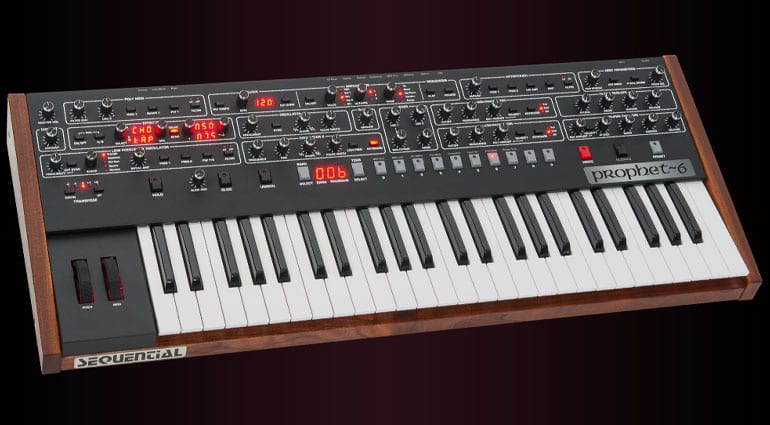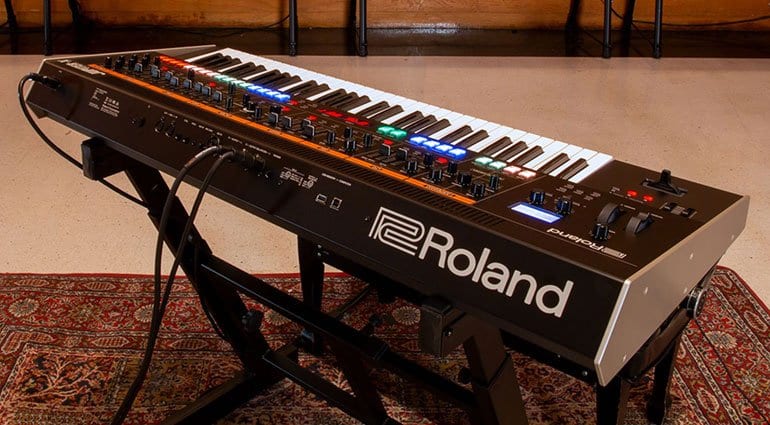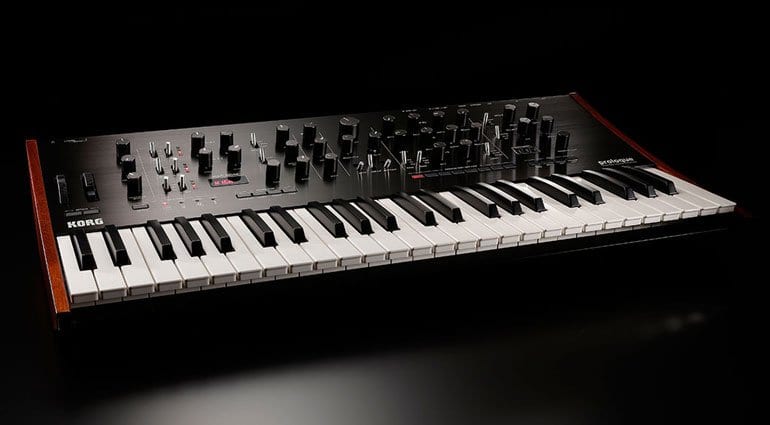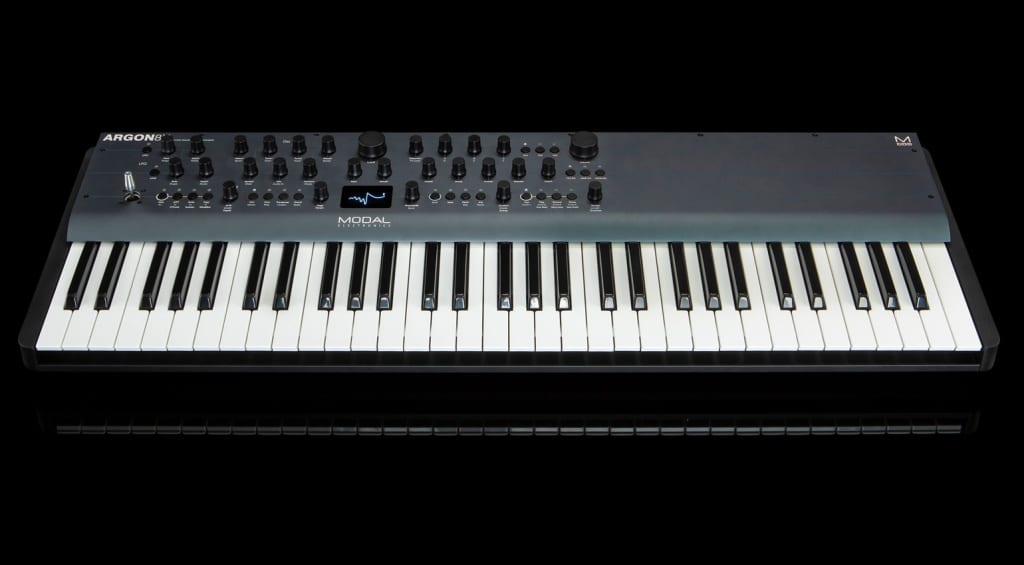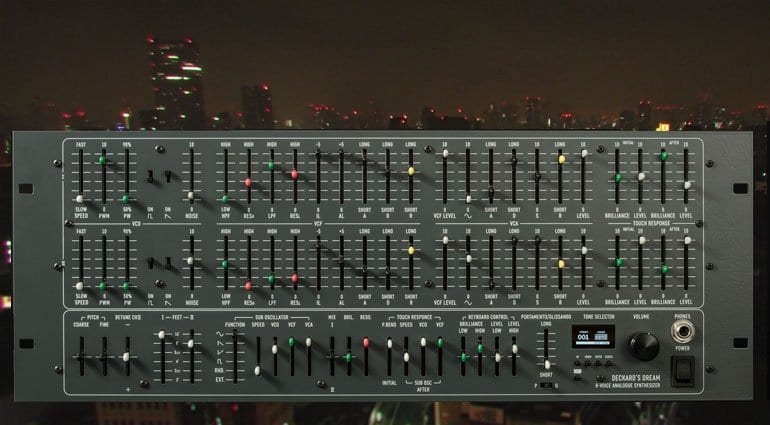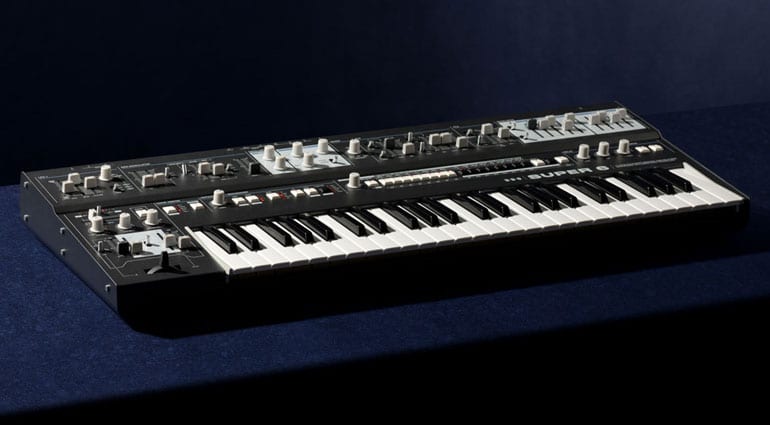This article is from an external source and may contain external links not controlled by Empeda Music.
gearnews.com

You’re standing in a showroom, hunting around for your very first polysynth. You’d imagined this would be a joyful experience. Now you’re frozen in the headlights of purchase anxiety surrounded by a horde of magical music machines. And you realise that you can’t choose just one. Gnashing your teeth, you curse the invention of the polyphonic synthesizer!
Buying your first polysynth
When talking about polysynths – polyphonic synthesizers – we’re talking about the big ones. The sort of synthesizers that dominate your desk, that could be a piece of furniture and are probably going to be a one-time investment using (if we’re honest) funds you don’t have to fulfil a need that’s really not there. But your level of GAS (gear acquisition syndrome) has got to the point that something has to give. My Facebook feed seems to be full of people with racks and racks of huge synths that they pick up on a whim. That’s fine, but this post is not about my next synth, this is about my first polysynth. And that’s not a whimsical thing; it’s torture.
- A word from the editor: this post contains affiliate links. Buying via an affiliate puts a small commission our way and helps to keep the lights on. But you pay the same price as you would have anyway. Sorry for the interruption!
The big workstations
Time and again in studios and on stage we find big workstation synths. In today’s money, you’d be looking at the Roland Fantom, Yamaha MOD-X and Korg Kronos. They have a huge range of production-ready sounds that cross genres, fit into mixes and are complex and selectable and fabulous and leave me absolutely stone cold. People undoubtedly make great music with them but my heart beats for something more analogue, something that’s all about the front panel, something that pulls you into sound design and hands-on action. I want a polysynth I can connect with, a muse rather than a solution to all my musical needs.
Sequential Circuits Prophet-5/Prophet-6
As a youth my dream synthesizer was a Sequential Circuits Prophet-5 and it’s amazing that 40 years later Sequential has a bunch of descendants offering exactly the same level of excitement that the Prophet-5 gave me all those years ago. The Prophet-6 is the most direct evolution with 6-voices of polyphonic analogue synthesis and a completely palpable vibe. People say great things about the Prophet Rev2 with its 16 voices, massive sounds, extensive modulation matrix and polyphonic step sequencing. And then there’s the OB-6, a classic collaboration between Dave Smith and Tom Oberheim that offers vintage tones over 6 voices. Each one looks like an instrument, sounds fantastic and must surely fulfil my criteria. Maybe, but are they edgy enough? Are they somehow too backwards-looking and not really pushing into those wider modern tones?
Roland Jupiter-X
What about the other big brands? Yamaha doesn’t seem to be able to see past the big workstation vibe so I’ll let them go. Roland is very much a forward-looking brand and by travelling into the future they seem certain that the path to perfect synthesis comes in software and advanced computer models. Their ZEN-Core technology is breath-taking and they are able to authentically recreate all their old synths while pushing into new ways of generating sound. The Jupiter-X is a huge synth that has that Jupiter-8 vibe that I find completely thrilling. But somehow the complexity of the sound engine gets lost in the translation to knobs and sliders which seem to only scratch the surface of the so many synthesizers within. The look alone is maybe enough to woo me.
Korg Prologue
Korg, on the other hand, doesn’t seem to be able to put a foot wrong. They consistently release pleasing machines immersing themselves in analogue while getting playful with the digital possibilities. At a synth event last year with many polysynths to play with I kept finding myself back on the Prologue. The dark look and the layout really worked for me. Whatever sound I dialled up was easily edited and quickly modified to become my own. There’s a digital edge of custom oscillators that can take you on lovely little adventures into tone. The Prologue feels natural, intuitive and has been poking at my wallet ever since. But it also feels….. I don’t know, safe?
The Novation Summit is another safe choice that you know would do a perfectly awesome job of being a decent, straight forward polysynth. But do I really want to make the sensible choice?
Going a little bit leftfield could take me into wavetable territory where I’d find the very reasonably priced Hydrasynth and Argon8. Both have brought out the possibilities of wavetable synths in wonderfully festooned front panels, masses of modulation and endless tonal possibilities. Or maybe Korg’s Wavestate would inject some excitement into my journey. I feel I might get lost in the search for the perfect wave and forget to play with what’s there.
Moog One and the Matriarch
My anxiety is intent on talking myself out of every possibility and so perhaps I should take my traumatised soul into the warm embrace of Moog. I’ve played with the Moog One, it’s a stunning synthesizer. It’s the sort of synthesizer you could spend the rest of your life exploring. You’d need to create some space for it. Ideally, it should sit dead centre in a large room on a vintage rug surrounded by potted plants and quadraphonic speakers. Your life will now be viewed exclusively through overexposed and deteriorating Super-8 film – and it will be awesome. For the price, I could buy a few of the other candidates and that makes it difficult to justify. The Matriarch, on the other hand, fits the budget better. It’s a future classic with a paint job that splits opinion and a sound that can make you cry real tears in 4-voices. It doesn’t have polyphonic articulation but it has 4 sweet oscillators and more charm than most synths can muster. It’s a real contender because it’s Moog, it’s modular, it’s groovy and to me it looks like a million bucks from the 1970s when a million bucks was a lot of money.
Don’t for a moment think this is settled quite yet.
Going back to my childhood I adored the Vangelis China album which led to a devotion to the Blade Runner soundtrack and ultimately the Yamaha CS-80. I have, for the past year, been building a Deckard’s Dream synthesizer which, in those moments when I think I might actually complete it, I must remind myself is a kick-ass polysynth based to some degree on the CS-80. So maybe I already have my dream polysynth. Maybe it’s purely my lack of time to finish such a detailed and involved DIY build that keeps me from having the synthesizer I’ve always wanted. Nah, it’s never going to work and it doesn’t have a keyboard so I can’t truly see it as the instrument my heart desires.
Udo Super-6
Which neatly brings me back around to the beginning of this conundrum. How do you choose your first polysynth? Maybe I’m taking it too seriously and I need to realise that there’s no perfect choice and it’s how you use your gear that’s important. But that line of thinking makes me feel I don’t really need one anyway. The UDO Super-6 has just become available and it sat there taunting me with its fingerable front panel, binaural spatialisation and digital fed analogue signal path. It has all the analogue I love and all the digital I could want to explore. A preorder button has never been hovered over so intently. But where’re the wooden cheeks, where’s the character in the design of the instrument? It looks somehow uncertain although the black gives it more gravitas. Dammit, I’m going to miss out on the first shipment.
So, how are you going to choose your first polysynth?
The post Your Ideal Polysnth: How (not) to choose the polyphonic synth of your dreams appeared first on gearnews.com.

